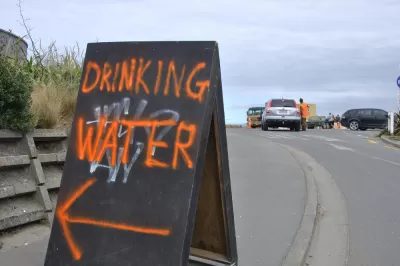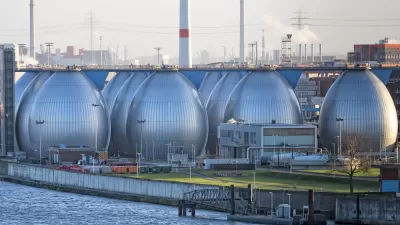In this radio report on the use of the expensive, controversial strategy of desalination to meet California's water needs in an epic drought, KQED's science reporter speaks with the mayor of Carmel, a V.P. of Poseidon Water, and an environmentalist.

Mayor Tom Burnett of Carmel-By-The-Sea, California finds himself in an unusual position. "Not only are his parents marine biologists, but his grandfather David Packard's Silicon Valley fortune laid the foundation for the Monterey Bay Aquarium," writes KQED science reporter Daniel Potter. [Listen here.] "Burnett himself used to work on climate rules for the EPA."
"It's quite expensive. It has a large carbon footprint. And there's real concerns about impact on marine life," he states. "So here I am, advocating a project that has a large carbon footprint and, if not done correctly, can hurt the oceans."
The Monterey Peninsula Water Supply Project (MPWSP) "will consist of a desalination plant, slant intake wells [for drawing seawater from underground rather than the water], pipelines for brackish water, pipelines for brine disposal, and production water delivery pipes, and is currently under construction," according to the project summary wiki. See Jan. 1 project newsletter [PDF].
Carmel was hit with a "cease-and-desist order to protect the Carmel River, the area's main source of drinking water for decades, forcing the surrounding towns to look for water somewhere else," states Potter.
"For us, desal really was the last option to consider," Burnett states. "But we got to that point."
Burnett is not only concerned with the large energy costs associated with reverse osmosis used to remove the salt from seawater but the environmental ones, "from the fish eggs that facilities can kill when they suck water in [although that is avoided by the MPWSP's slant wells] to what happens when they dump all the leftover salt back out to sea [also avoided, claims project builder California-American Water Company]," states Potter.
And then there's the carbon footprint, as Mayor Burnett indicated. Ironically, advocates use climate change as the reason why more regions in the state need to consider building desalination plants due to its effect on the state's traditional water supply, the Sierra snowpack.
"(T)he larger concern is climate change and what happens 10 years and 20 years from now," states Scott Maloni, vice president of Poseidon Water." Poseidon is building the country's biggest desalination plant in Carlsbad. "Can we really count on the Colorado River or Northern California to continue to supply the vast majority of the state's population with water?" asks Maloni.
Environmentalist Susan Jordan, with the California Coastal Protection Network sees desalination as enabling more unsustainable growth.
If you're going to do something like desal, you want to make sure that you're doing everything you can in terms of conservation, water recycling, water reuse. And you don't want to fuel unsustainable development that just perpetuates your problem.
Jordan's points appear to largely coincides with those made by Eduardo Porter, Economic Scene columnist for The New York Times made here earlier this month.
FULL STORY: Desalination Plants: Drought Cure Or Growth Enabler?

Maui's Vacation Rental Debate Turns Ugly
Verbal attacks, misinformation campaigns and fistfights plague a high-stakes debate to convert thousands of vacation rentals into long-term housing.

Planetizen Federal Action Tracker
A weekly monitor of how Trump’s orders and actions are impacting planners and planning in America.

In Urban Planning, AI Prompting Could be the New Design Thinking
Creativity has long been key to great urban design. What if we see AI as our new creative partner?

King County Supportive Housing Program Offers Hope for Unhoused Residents
The county is taking a ‘Housing First’ approach that prioritizes getting people into housing, then offering wraparound supportive services.

Researchers Use AI to Get Clearer Picture of US Housing
Analysts are using artificial intelligence to supercharge their research by allowing them to comb through data faster. Though these AI tools can be error prone, they save time and housing researchers are optimistic about the future.

Making Shared Micromobility More Inclusive
Cities and shared mobility system operators can do more to include people with disabilities in planning and operations, per a new report.
Urban Design for Planners 1: Software Tools
This six-course series explores essential urban design concepts using open source software and equips planners with the tools they need to participate fully in the urban design process.
Planning for Universal Design
Learn the tools for implementing Universal Design in planning regulations.
planning NEXT
Appalachian Highlands Housing Partners
Mpact (founded as Rail~Volution)
City of Camden Redevelopment Agency
City of Astoria
City of Portland
City of Laramie




























